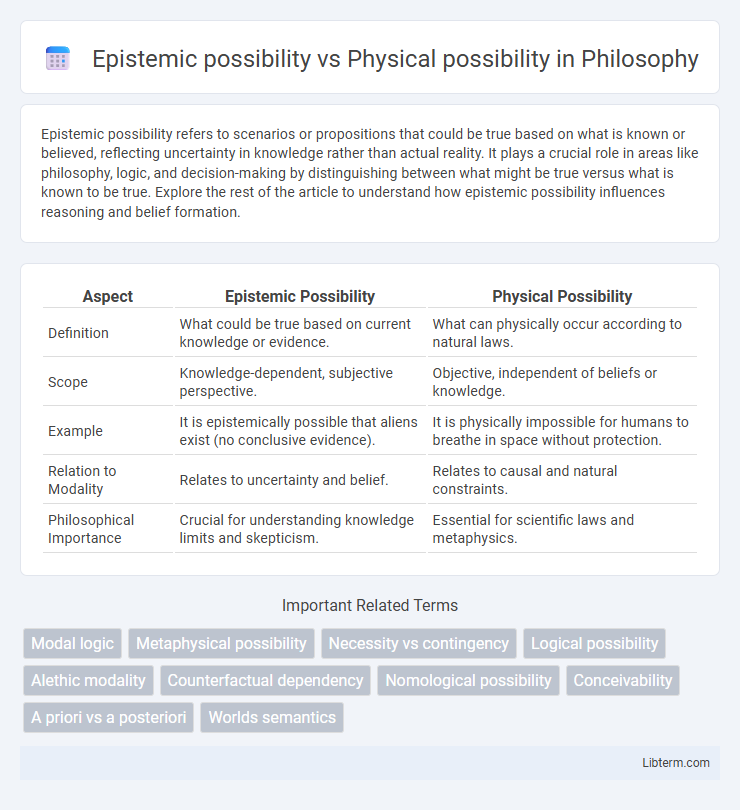Epistemic possibility refers to scenarios or propositions that could be true based on what is known or believed, reflecting uncertainty in knowledge rather than actual reality. It plays a crucial role in areas like philosophy, logic, and decision-making by distinguishing between what might be true versus what is known to be true. Explore the rest of the article to understand how epistemic possibility influences reasoning and belief formation.
Table of Comparison
| Aspect | Epistemic Possibility | Physical Possibility |
|---|---|---|
| Definition | What could be true based on current knowledge or evidence. | What can physically occur according to natural laws. |
| Scope | Knowledge-dependent, subjective perspective. | Objective, independent of beliefs or knowledge. |
| Example | It is epistemically possible that aliens exist (no conclusive evidence). | It is physically impossible for humans to breathe in space without protection. |
| Relation to Modality | Relates to uncertainty and belief. | Relates to causal and natural constraints. |
| Philosophical Importance | Crucial for understanding knowledge limits and skepticism. | Essential for scientific laws and metaphysics. |
Introduction to Epistemic and Physical Possibility
Epistemic possibility refers to what could be true given the available knowledge or evidence, emphasizing uncertainty and information limitations. Physical possibility concerns what can occur within the laws of nature and physical reality regardless of our knowledge. Understanding the distinction highlights how epistemic possibility is tied to cognitive states, while physical possibility depends on objective constraints.
Defining Epistemic Possibility
Epistemic possibility refers to what could be true given current knowledge or evidence, emphasizing uncertainty and incomplete information. It contrasts with physical possibility, which concerns what can occur according to the laws of nature regardless of knowledge. Defining epistemic possibility involves recognizing scenarios not ruled out by existing evidence, reflecting states of belief or information rather than actual physical constraints.
Understanding Physical Possibility
Physical possibility refers to whether an event or state can occur within the actual laws of nature and constraints of the physical world, irrespective of what is known or believed. Unlike epistemic possibility, which depends on knowledge and uncertainty, physical possibility centers on what is objectively feasible given scientific principles and causal mechanisms. Understanding physical possibility involves analyzing natural laws, material conditions, and energy requirements that govern what can happen in reality.
Key Differences Between Epistemic and Physical Possibility
Epistemic possibility refers to what could be true based on what is known or unknown, emphasizing knowledge and uncertainty, while physical possibility concerns what can exist or occur within the laws of nature and physical reality. Key differences include that epistemic possibility is contingent on an agent's information and beliefs, making it subjective, whereas physical possibility is objective and constrained by natural laws. Consequently, something may be epistemically possible without being physically possible, highlighting the distinction between what we can conceive and what is physically feasible.
Importance in Philosophy and Science
Epistemic possibility concerns what could be true given our current knowledge, while physical possibility relates to what can occur within the laws of nature. Distinguishing between these types is crucial in philosophy for evaluating knowledge claims and understanding the limits of human cognition. In science, this differentiation guides hypothesis testing and the interpretation of empirical data, ensuring theories remain grounded in physical reality while acknowledging uncertainty.
Examples Illustrating Epistemic Possibility
Epistemic possibility refers to what could be true given what is known or not yet known, such as a detective considering a suspect might have been at the crime scene without concrete proof. For example, it is epistemically possible that an unopened letter contains a secret message, even though physically the letter is sealed and the message either exists or does not. Another illustration is the belief that extraterrestrial life might exist somewhere in the universe, which remains epistemically possible based on current knowledge despite the lack of empirical evidence.
Examples Demonstrating Physical Possibility
A car running on a flat road at 60 miles per hour is a clear example of physical possibility, as it conforms with the laws of physics and engineering constraints. Similarly, water boiling at 100 degrees Celsius under standard atmospheric pressure demonstrates physical possibility due to established thermodynamic principles. In contrast, Epistemic possibility concerns what could be true given knowledge limitations, whereas physical possibility depends strictly on natural laws and factual consistency.
Implications for Knowledge and Reality
Epistemic possibility pertains to what could be true given current knowledge, highlighting the limits of our understanding and the potential for future discovery, while physical possibility concerns what can actually occur within the laws of nature, grounding reality in observable phenomena. This distinction implies that knowledge is always provisional and subject to revision, whereas reality is constrained by objective physical principles. Recognizing this difference is crucial for evaluating scientific theories and philosophical claims, as it frames the boundaries between belief, uncertainty, and empirical fact.
Common Confusions and Misconceptions
Epistemic possibility refers to what could be true based on current knowledge, whereas physical possibility concerns what can actually occur within the laws of nature. A common confusion arises when people mistake epistemic possibility for physical possibility, assuming that if something is not known to be false, it must be physically attainable. Misconceptions often lead to debates in philosophy and science where hypothetical scenarios are incorrectly treated as feasible events.
Conclusion: Navigating Possibility in Theory and Practice
Epistemic possibility relates to what could be true given our current knowledge, while physical possibility concerns what can occur within the laws of nature. Navigating these concepts allows theorists and practitioners to differentiate between uncertainty in understanding and real-world constraints, optimizing decision-making and predictive models. Recognizing this distinction is crucial for effective problem-solving across scientific and philosophical domains.
Epistemic possibility Infographic

 libterm.com
libterm.com